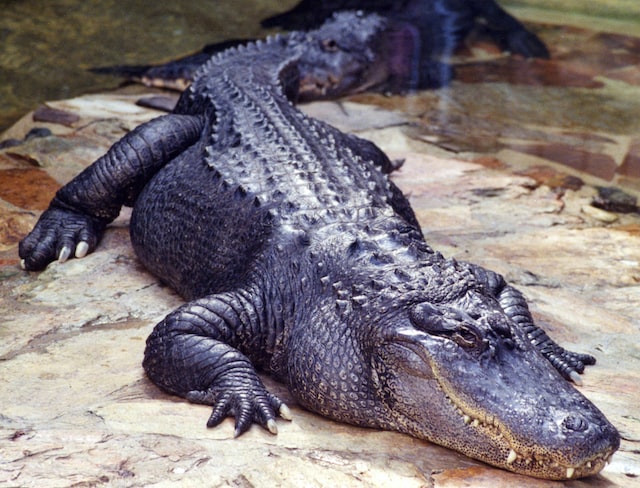This group of dinosaurs includes the American Alligator. Reptiles like the crocodile, caiman, gavial, and alligator can be found in warm to tropical regions. Africa, Southeast Asia, and Northern Australia are all home to crocodiles. Caimans are native to the northern parts of South America.
The Gharial crocodile is the most exotic of all crocodile species. Its gavial, or long slender nose, allows it to catch fish while lying on its side. The fish is flipped over and swallowed headfirst. To attract a mate, male gharials blow air via their large nostrils.

Alligators, Crocodiles, and Gharial are Different Species
Related but distinct species include the alligator, crocodile, caiman, and gharial. The “U” shaped muzzle of a gator allows it to crush its food more effectively when feeding on turtles and other reptiles.
Crocs’ snouts are shaped like a “V,” as the name implies. Even with its mouth closed, the Croc will show teeth. Crocodiles can rid themselves of excess salt because to specialised glands in their tongues.
A similar set of structures can be found in a gator, but they serve no purpose. This means that alligators, unlike crocodiles, are nearly entirely confined to fresh water.
Read Also:
Differences Between Crocodiles, Gharials, And Alligators
In spite of their similarities, crocodiles, alligators, and gharials are each distinctly different.
Although they share a common ancestor in the class Reptilia and the order Crocodilia, each of these crocodilian families is distinct.
The gharial is easily distinguishable from other crocodiles and alligators thanks to its very large snout.
Different Families
Crocodilians can be broken down into three families: the Alligatoridae (alligators), the Crocodylidae (crocodiles), and the Gavialidae (gavialis) (gharial).
All three groups belong to the Reptilia class and the Crocodilia order. The species have diverged by over 40 million years of evolution, yet researchers think they share a common ancestor.
Jaw Shape
The long, slender jaws of a gharial are a telltale sign of the animal. Fish make up the bulk of the gharial’s diet, and the mouth is built for swift manoeuvrability to capture them.
Distance can make it harder to tell the difference between the jaws of crocodiles and alligators. While alligators have rounded, U-shaped snouts, crocodiles have long, pointed V-shaped nostrils.
The alligator’s snout is built for durability, so it can take a beating when the animal uses its whole weight to crack shells and crack bones.
The crocodile’s V-shaped snout may not be as strong as the alligator’s, but it can still deliver a nasty bite. The jaw structure allows the animal to consume numerous food types.
Teeth Placement
Gharial snouts are long and slender, and their mouths are stuffed with roughly 110 teeth: 50-52 in the lower jaw and 54-58 in the upper.
The largest teeth are located in the front of the mouth, where they are used for gripping.
When an alligator closes its mouth, the teeth of its lower jaw exactly fit into the sockets or depressions of the upper jaw because the alligator’s top jaw is wider than its lower jaw.
Crocodiles’ upper and lower jaws are nearly the same width, and their teeth align along the margin. The top and lower sets of crocodile teeth interlock when the animal closes its mouth.
Lingual Salt Glands
In contrast to alligators, gharials and crocodiles have salt glands on their tongues, which are actually modified salivary glands. The same mechanisms that allowed alligators to secrete salt in the past are now obsolete.
Salt glands allow crocodiles and gharials to spend more time in the open ocean because of their increased tolerance of salty water.
Due to their capacity to cross large quantities of water, crocodiles can be found all over the world. Moreover, saltwater crocodiles are able to survive for long periods of time in coastal areas, even venturing offshore in search of food.
Alligators like freshwater environments and can only survive there for brief periods of time.
Read Also:
Conclusion
Giant aquatic reptiles such as crocodiles, alligators, and gharials are found in many parts of the world. Africa, Asia, Australia, and North America are all home to crocodiles, while both the Americas and Asia are inhabited by alligators. Gharials are endemic to only India and its immediate neighbours.




